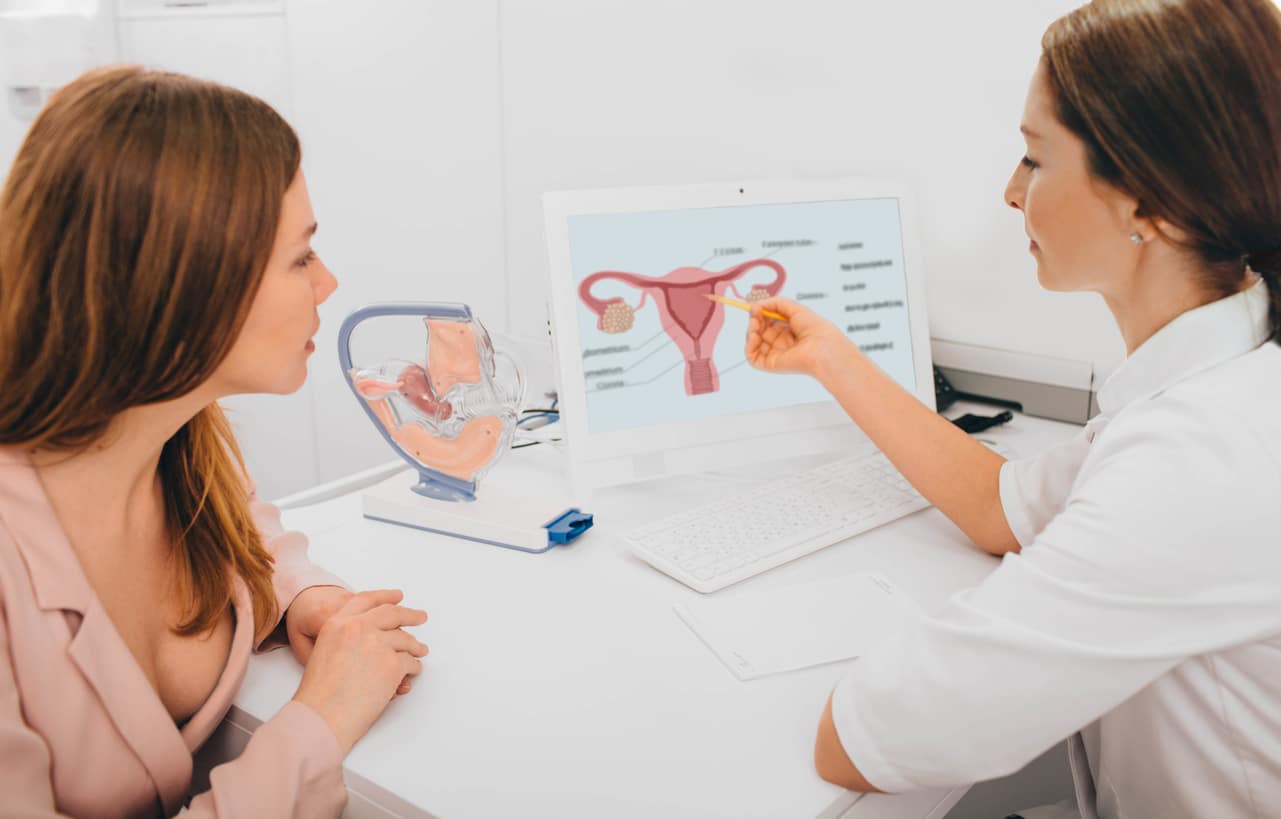Endometriosis is a painful medical condition that affects many women. It occurs when the endometrium (the tissue that normally lines the uterus) grows beyond the uterus and into other parts of the pelvic area. Endometriosis most commonly affects the ovaries, fallopian tubes and bowels, and the pelvic region behind the uterus.

In rare cases, endometrial tissue can spread beyond the pelvis to other areas of the body. At Craig Ranch OB/GYN, located in Mckinney, Texas, our team of exceptionally skilled doctors can help you manage your Endometriosis.
How Serious Is Endometriosis?
Endometriosis is usually not a serious condition, but it can cause chronic pain and interfere with daily life. During normal menstruation, the endometrial tissue swells and bleeds, and is shed from the uterine lining. When endometrial tissue grows outside the uterine wall, it can swell and form scar tissue, causing pain and discomfort. Endometriosis can develop any time after a woman begins menstruating but is typically seen in women in their 30s or 40s. Although some women with endometriosis experience little or no discomfort, others suffer from considerable pain and, in some cases, may experience fertility problems. Dr. Shimer and Dr. Joyner along with their knowledgeable staff are leading experts that will stop at nothing to help you.
What Can Cause Endometriosis?
While the exact cause of endometriosis is unknown, some research indicates that it may be hereditary. Women who have never had children or who experience longer than normal menstrual cycles may also be more likely to develop endometriosis. Additional causes may include the following:
- Retrograde menstruation (menstrual blood flows into fallopian tubes and pelvic cavity)
- Excessive growth of embryonic cells
- Attachment of endometrial cells to a scar after a surgical incision
Endometriosis may also be caused by an immune-system disorder that makes the body unable to detect or destroy endometrial tissue growing outside the uterus.
Endometriosis Symptoms
In most cases, endometriosis is characterized by severe pelvic or lower-back pain, usually occurring during menstruation. Other common symptoms of endometriosis may include the following:

- Excessive menstrual bleeding
- Pain during or after sexual intercourse
- Painful urination or an increase in its frequency
- Infertility
- Pelvic cramping or pain that has been worsening
- Vomiting or nausea
- Exhaustion
Bowel movements may also be affected by endometriosis, and many women suffer from constipation and diarrhea.
Patient Testimonials
This office is awesome! All the Doctors are so caring and really take their time with their patients. They addressed all my concerns and I did not feel rushed at all. The office is beautiful and so clean. The office staff was very helpful and knowledgeable. I could tell they all enjoy their jobs. I highly recommend Craig Ranch OB/GYN.
I love this place! They are never late to take you back and appointments are quick and easy. They are super knowledgable and the office is spotless. The doctor is so welcoming and listens to any concerns you may have.
Diagnosis Of Endometriosis In Mckinney, Texas
Doctors often first suspect endometriosis based on the patient’s symptoms. Once a medical history has been taken, a pelvic examination is performed. Diagnosis is typically confirmed through screening with ultrasound, MRI scan or diagnostic laparoscopy, which provide internal views of the abdominal area.
What Treatment Do You Offer For Endometriosis?
Depending on a patient’s symptoms, treatment for endometriosis varies. In milder cases of endometriosis, conservative methods are often effective at alleviating symptoms.

Conservative methods of treatment include over-the-counter or prescription pain relievers, and birth control pills to regulate hormones. If the condition does not respond to treatment with medication, surgery to remove excess endometrial tissue may be required.
How does endometriosis affect my ability to get pregnant?
The main complication of endometriosis is lowered fertility. Approximately one-third to one-half of women with endometriosis have trouble getting pregnant.
This is because endometriosis can obstruct the fallopian tube. For successful pregnancy, an egg is released by an ovary and it then travels through the nearby fallopian tube where it becomes fertilized by the sperm cell. The egg then attaches itself to the uterine wall where it begins developing. When endometriosis obstructs the tube, it keeps the sperm and egg from uniting.
Endometriosis also seems to affect pregnancy in less-direct ways, such as by damaging the sperm or the egg.
When is surgery necessary for endometriosis?
If a patient is trying to become pregnant, she may have surgery to remove the endometriosis implants while still preserving the uterus and the ovaries. This is considered “conservative” surgery as it preserves those parts of the pelvic area.
At Craig Ranch OB/GYN, we can usually perform these surgeries laparoscopically.
A hysterectomy, surgery removing the uterus and ovaries (oophorectomy), formerly was the surgery used to treat endometriosis, but we avoid this option if at all possible. A woman having her ovaries removed results in her going into menopause. This early entry into menopause carries risks of cardiovascular disease and certain metabolic conditions. Removal of the uterus before the age of 35 also can have long-term effects on the woman’s health.
What are the four stages of endometriosis?
Being able to see endometriosis implants and scarring is what enables doctors to classify the different stages of the disease. Numbers are used, and a score of 15 or less means that the disease, visually, is either in Stage 1 or Stage 2. A score of 16 to 40 means the disease is Stage 3, and 40 or more puts the disease as severe, Stage 4. These are the categorizations of endometriosis:
Endometriosis is categorized into four different stages:
- Stage 1 (1 to 5 points) — Endometriosis in this stage is considered to be minimal. The implants are small, few in number, and shallow. This doesn’t mean the pain is minimal, and it doesn’t mean there isn’t significant impact on the woman’s life.
- Stage 2 (6 to 15 points) — This is considered to be mild endometriosis. We may find more implants, and they are deeper than the superficial implants found in stage 1 endometriosis.
- Stage 3 (16 to 40 points) — This is moderate endometriosis. Not only are there many deep endometrial implants, but there may be endometrial cysts on at least one ovary. These cysts form when the tissue attaches to an ovary and begins to shed blood and tissue. The blood collects and turns brown. Because of that, these are sometimes called “chocolate cysts.” We may also find thin bands of tissue, called filmy adhesions, that bind organs together. These adhesions are the scar tissue that forms when the body tries to heal from the inflammation caused by endometriosis. This can lead to sharp, stabbing pain and nausea.
- Stage 4 (40 or more points) — This is severe endometriosis. In addition to many deep endometriosis implants, there are large cysts on at least one ovary and many dense adhesions throughout the pelvic region.
What are the risks involved with having a hysterectomy for endometriosis?
A hysterectomy is generally a safe procedure, but there are some risks involved:
These include:
- Urinary incontinence
- Vaginal prolapse (part of the vagina coming out of the body)
- Vaginal fistula formation (an abnormal connection that forms between the vagina and the bladder or rectum)
- Chronic pain
- Blood clot formation
- Infection
- Excessive bleeding
- Damage to your urinary tract, bladder, rectum, or other pelvic structures during the surgery
- Early onset of menopause, even if the ovaries aren’t removed.
- Early menopause carries risks of cardiovascular diseases and certain metabolic disorders

Is endometriosis hereditary?
There is some evidence that endometriosis could have a genetic component. If you have a mother, aunt, or sister who has endometriosis, this elevates your risk.
Can a pap smear detect endometriosis?
Not all women exhibit symptoms with endometriosis. Their lesions can be discovered during a pelvic exam. Unusual results from a pap smear may also alert us to your endometriosis.
Often, when we do see lesions, we will perform a pap smear to check for abnormal results. If your pap smear then shows irregular results, we will likely perform a colposcopy.
Minimally Invasive Surgery For Endometriosis At Craig Ranch OB/GYN
Surgery for endometriosis is usually performed through minimally invasive laparoscopy, which can thoroughly remove the endometrial tissue. Severe cases of endometriosis may require a hysterectomy, which involves the removal of the uterus and cervix. This may help to eliminate the severe pain caused by endometriosis. However, a hysterectomy is typically considered a last-resort form of treatment, especially for women of childbearing age, because they will no longer be able to bear children.

Currently, there is no cure for endometriosis and no certain method for its prevention. Some women find it beneficial to attend support groups with other women who suffer from endometriosis. With proper treatment and medical attention, endometriosis can be well managed. With proper help from your OB/GYN, your Endometriosis can be turned around and you can get back to living the life you deserve.
Schedule A Consultation
To schedule your consultation at our McKinney, TX office, call 214.544.6600. The providers at Craig Ranch OB/GYN are proud to serve patients in McKinney and surrounding areas of Texas.
